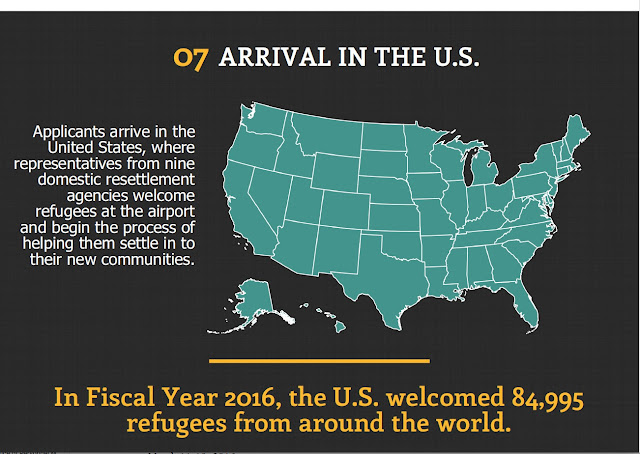In Fiscal Year 2016, the United States welcomed 84,995 refugees from around the world. In Fiscal Year 2017, which began on Oct. 1st, the United States was supposed to welcome another 110,000 refugees; however, President Donald Trump has limited the number of refugees to the United States from around the world to 50,000 for Fiscal Year 2017.
According to The New York Times, more than 37,000 refugees have already entered the United States since the 1st of October, leaving only 12,700 slots remaining under President Trump's limit for the remainder of this fiscal year.
Are the purposes of President Trump's ban on travel and his limits on the Refugee Admissions Program purely to enhance security for the United States, or are they simply a means to fulfill a campaign promise to ban Muslims from the United States?
Are the hoops and hurdles of security procedures under the U.S. Refugee Admissions Program, which take anywhere from 18 to 24 months to complete, already stringent enough?
You be the Judge:
U.S. Refugee Admissions Program
According to The New York Times, more than 37,000 refugees have already entered the United States since the 1st of October, leaving only 12,700 slots remaining under President Trump's limit for the remainder of this fiscal year.
Are the purposes of President Trump's ban on travel and his limits on the Refugee Admissions Program purely to enhance security for the United States, or are they simply a means to fulfill a campaign promise to ban Muslims from the United States?
Are the hoops and hurdles of security procedures under the U.S. Refugee Admissions Program, which take anywhere from 18 to 24 months to complete, already stringent enough?
You be the Judge:
U.S. Refugee Admissions Program
Application and Case Processing
When UNHCR — or, occasionally, a U.S. Embassy or a specially trained nongovernmental organization — refers a refugee applicant to the United States for resettlement, the case is first received and processed by a Resettlement Support Center (RSC). The U.S. Department of State’s Bureau of Population, Refugees and Migration (PRM) funds and manages nine RSCs around the world, operated by international and nongovernmental organizations and one U.S. interests section. Under PRM’s guidance, the RSCs prepare eligible refugee applications for U.S. resettlement consideration.
Some refugees can start the application process with the RSC without a referral from UNHCR or other entity. This includes close relatives of asylees and refugees already in the United States and refugees who belong to specific groups set forth in statute or identified by the Department of State as being eligible for direct access to the program.
The RSCs collect biographic and other information from the applicants to prepare for the adjudication interview and for security screening. Enhanced security screening is a joint responsibility of the Department of State and the Department of Homeland Security and includes the participation of multiple U.S. Government security agencies.
Officers from the Department of Homeland Security’s U.S. Citizenship and Immigration Services (USCIS) review all the information that the RSC has collected and also conduct an in-person interview with each refugee applicant before deciding whether to approve him or her for resettlement in the United States.
All USCIS-approved refugees undergo a health screening to identify medical needs and to ensure that those with a contagious disease, such as tuberculosis, do not enter the United States. Finally, the RSC requests a “sponsorship assurance” from a U.S.-based resettlement agency that is experienced in providing assistance to newly arrived refugees. Most refugees undergo a brief U.S. cultural orientation course prior to departure for the United States.
Those refugees who are approved by USCIS receive assistance upon arrival in the United States through the Department of State’s Reception and Placement Program – a cooperative public-private program made up of a number of participants. The support of millions of Americans is fundamental to the program’s success. Though Congress mandated the program, it is local communities that have ensured the success of the resettlement program by welcoming and helping refugees from around the world.
United States Refugee Admissions Program (USRAP) is comprised of:
- The Bureau of Population, Refugees and Migration (PRM) of the U.S. Department of State.
- U.S. Citizenship and Immigration Services (USCIS) of the U.S. Department of Homeland Security.
- The Office of Refugee Resettlement (ORR) of the U.S. Department of Health and Human Services.
- Five international or nongovernmental organizations operating Resettlement Support Centers around the world under the supervision and funding of the Bureau of Population, Refugees and Migration (PRM) of the U.S. Department of State
- Nine domestic nongovernmental organizations with a total of about 350 affiliated offices across the United States.
- Thousands of private citizens who volunteer their time and skills to help refugees resettle in the United States.
The total processing time varies depending on an applicant’s location and other circumstances, but the average time from the initial UNHCR referral to arrival as a refugee in the United States is about 18-24 months.
I copied and pasted the above information from the Department of State website just in case the information on the website is deleted by the Trump Administration.
https://www.state.gov/j/prm/ra/admissions/












